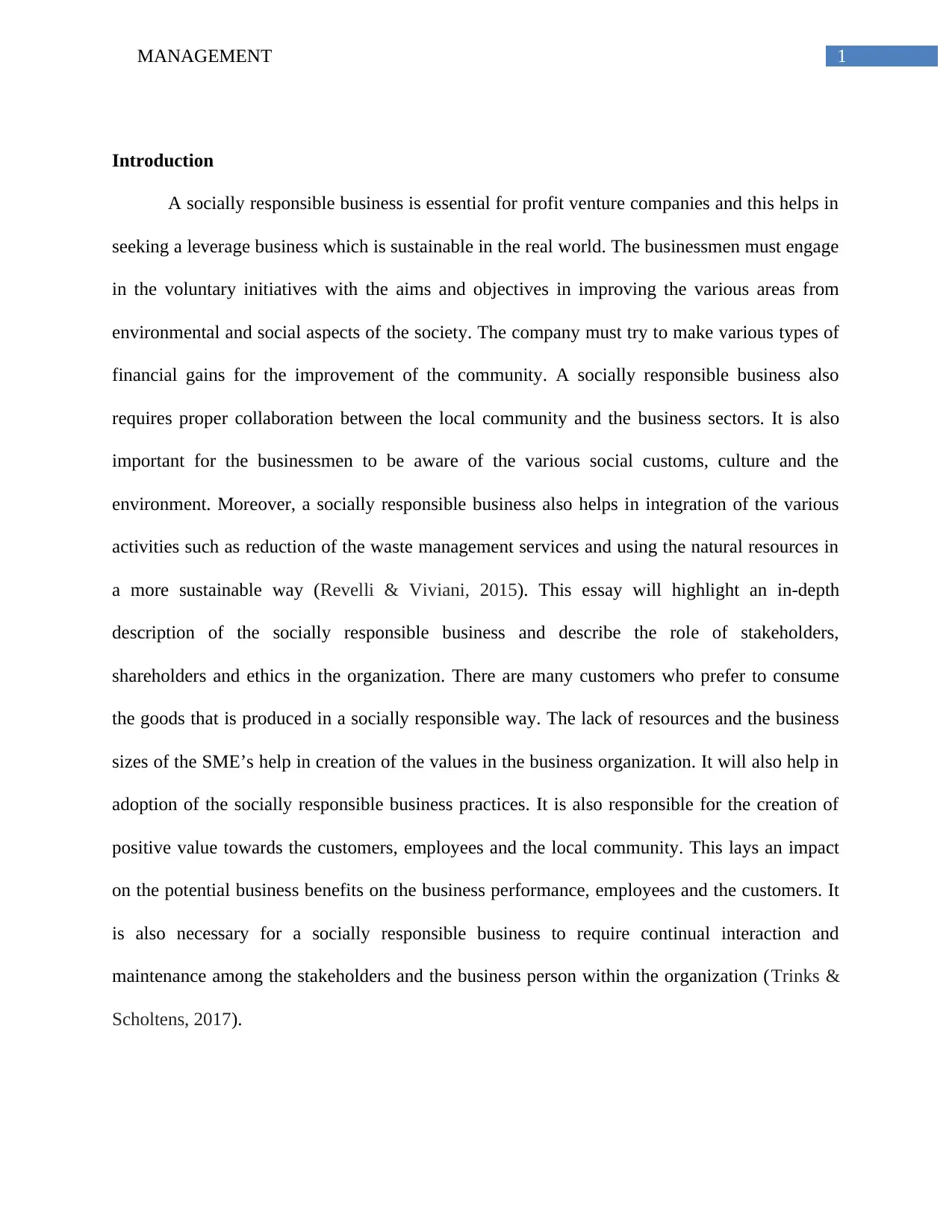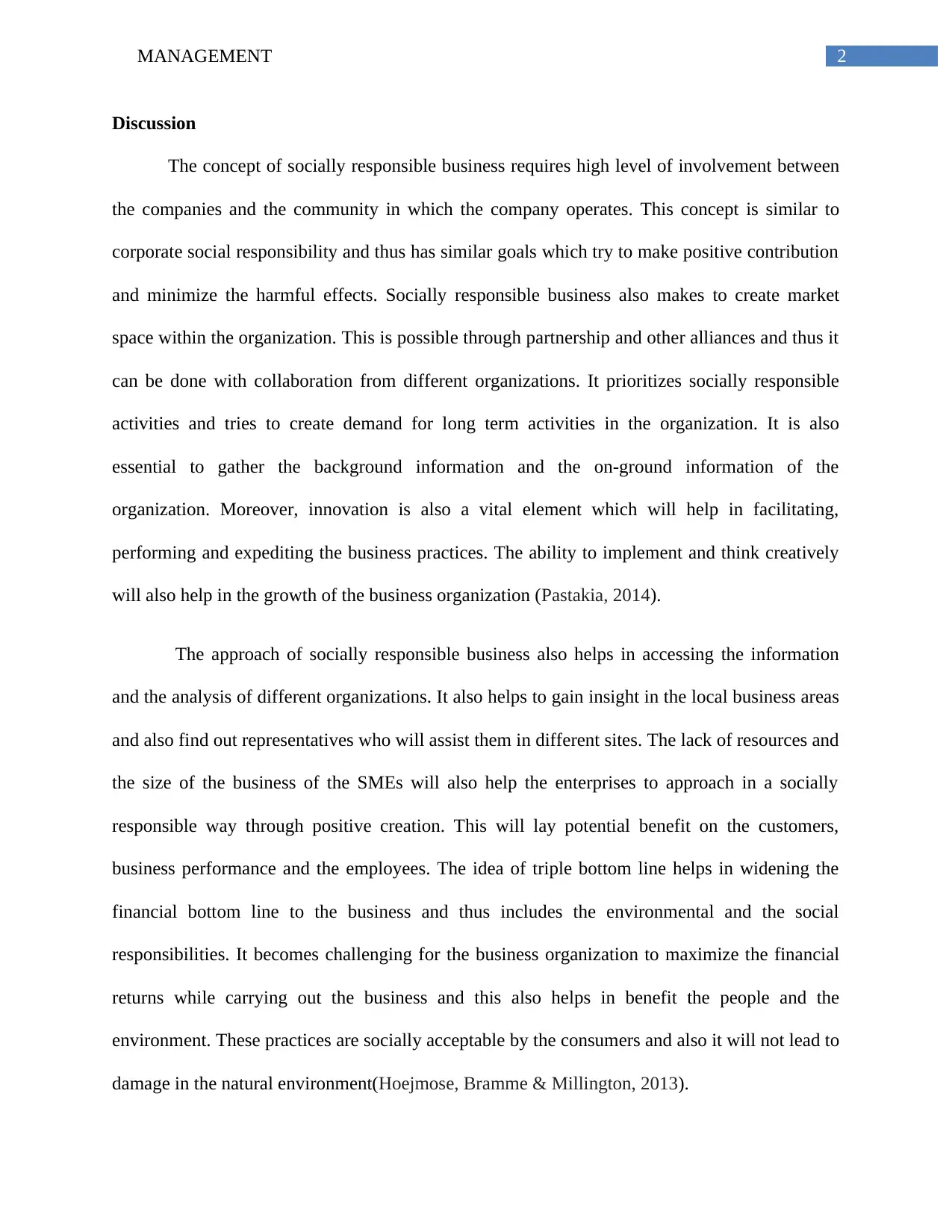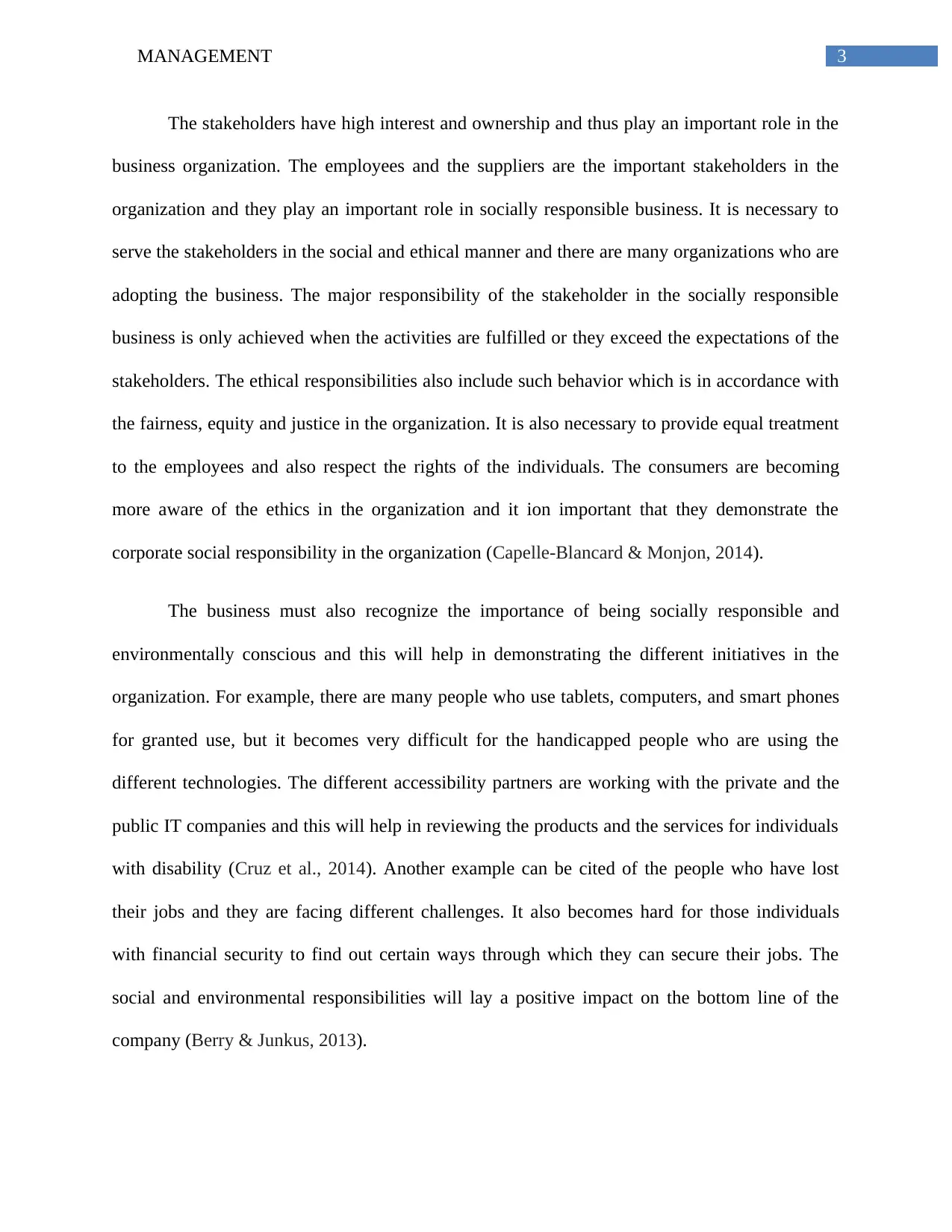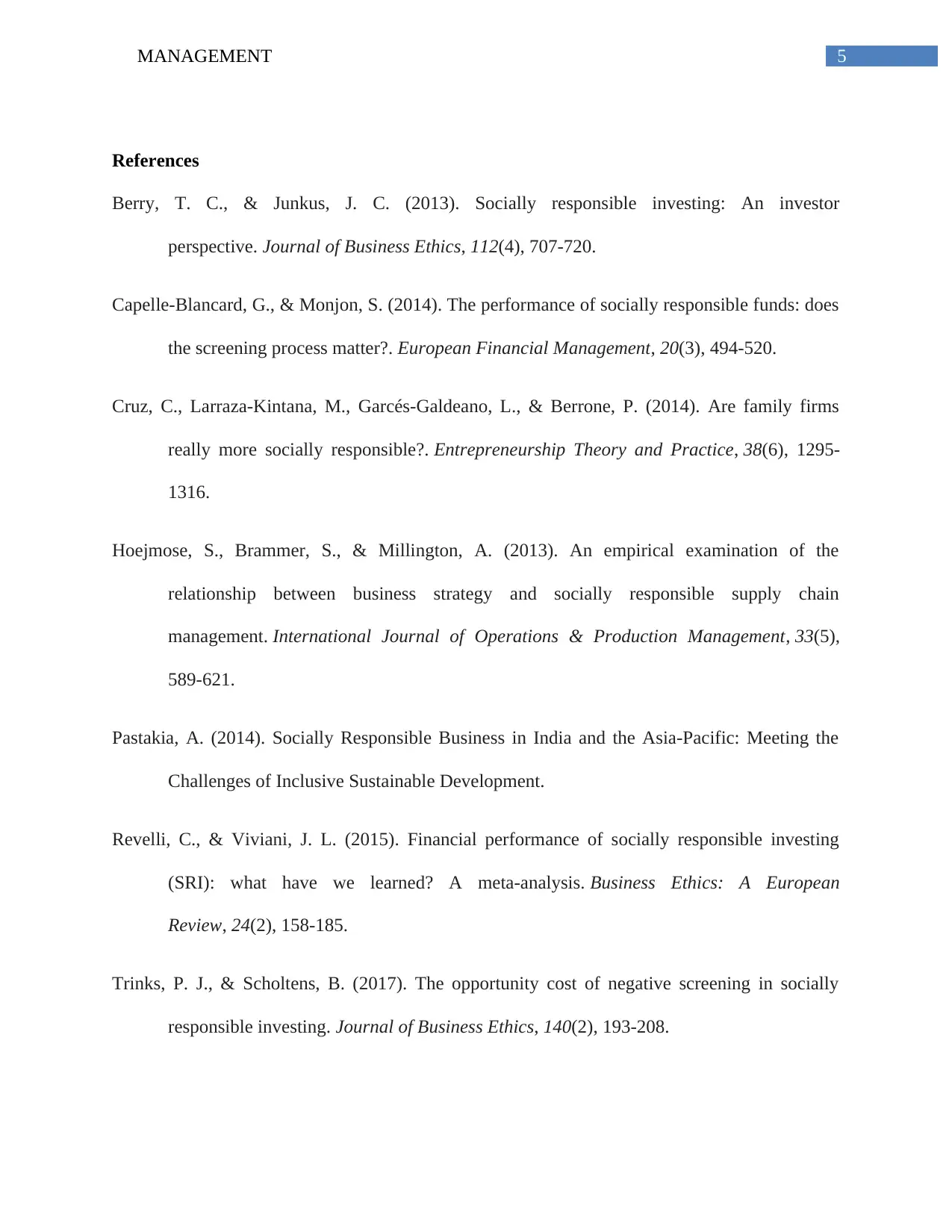Management Essay: Stakeholders, Ethics, and Social Responsibility
VerifiedAdded on 2020/05/03
|6
|1431
|67
Essay
AI Summary
This essay provides an in-depth analysis of socially responsible business practices, emphasizing their significance for sustainable business models. It explores the critical roles of stakeholders, including employees, suppliers, and customers, and their impact on ethical considerations within an organization. The essay defines socially responsible businesses as those that actively engage in voluntary initiatives to improve environmental and social aspects, aiming to create financial gains for the community. It highlights the importance of collaboration between local communities and businesses, alongside an awareness of social customs and environmental factors. The discussion covers the integration of activities like waste reduction and sustainable resource use, and the creation of positive value for customers, employees, and the local community. The essay also discusses the triple bottom line approach, stakeholder engagement, and the importance of ethical responsibilities in business operations, emphasizing the need for corporate social responsibility and its positive impact on the company's bottom line. Finally, it concludes by suggesting that the business must be established in such a way that it will decrease the threats and increase the benefits of the company.

Running head: MANAGEMENT
Management
Name of the Student:
Name of the University:
Author Note:
Management
Name of the Student:
Name of the University:
Author Note:
Paraphrase This Document
Need a fresh take? Get an instant paraphrase of this document with our AI Paraphraser

1MANAGEMENT
Introduction
A socially responsible business is essential for profit venture companies and this helps in
seeking a leverage business which is sustainable in the real world. The businessmen must engage
in the voluntary initiatives with the aims and objectives in improving the various areas from
environmental and social aspects of the society. The company must try to make various types of
financial gains for the improvement of the community. A socially responsible business also
requires proper collaboration between the local community and the business sectors. It is also
important for the businessmen to be aware of the various social customs, culture and the
environment. Moreover, a socially responsible business also helps in integration of the various
activities such as reduction of the waste management services and using the natural resources in
a more sustainable way (Revelli & Viviani, 2015). This essay will highlight an in-depth
description of the socially responsible business and describe the role of stakeholders,
shareholders and ethics in the organization. There are many customers who prefer to consume
the goods that is produced in a socially responsible way. The lack of resources and the business
sizes of the SME’s help in creation of the values in the business organization. It will also help in
adoption of the socially responsible business practices. It is also responsible for the creation of
positive value towards the customers, employees and the local community. This lays an impact
on the potential business benefits on the business performance, employees and the customers. It
is also necessary for a socially responsible business to require continual interaction and
maintenance among the stakeholders and the business person within the organization (Trinks &
Scholtens, 2017).
Introduction
A socially responsible business is essential for profit venture companies and this helps in
seeking a leverage business which is sustainable in the real world. The businessmen must engage
in the voluntary initiatives with the aims and objectives in improving the various areas from
environmental and social aspects of the society. The company must try to make various types of
financial gains for the improvement of the community. A socially responsible business also
requires proper collaboration between the local community and the business sectors. It is also
important for the businessmen to be aware of the various social customs, culture and the
environment. Moreover, a socially responsible business also helps in integration of the various
activities such as reduction of the waste management services and using the natural resources in
a more sustainable way (Revelli & Viviani, 2015). This essay will highlight an in-depth
description of the socially responsible business and describe the role of stakeholders,
shareholders and ethics in the organization. There are many customers who prefer to consume
the goods that is produced in a socially responsible way. The lack of resources and the business
sizes of the SME’s help in creation of the values in the business organization. It will also help in
adoption of the socially responsible business practices. It is also responsible for the creation of
positive value towards the customers, employees and the local community. This lays an impact
on the potential business benefits on the business performance, employees and the customers. It
is also necessary for a socially responsible business to require continual interaction and
maintenance among the stakeholders and the business person within the organization (Trinks &
Scholtens, 2017).

2MANAGEMENT
Discussion
The concept of socially responsible business requires high level of involvement between
the companies and the community in which the company operates. This concept is similar to
corporate social responsibility and thus has similar goals which try to make positive contribution
and minimize the harmful effects. Socially responsible business also makes to create market
space within the organization. This is possible through partnership and other alliances and thus it
can be done with collaboration from different organizations. It prioritizes socially responsible
activities and tries to create demand for long term activities in the organization. It is also
essential to gather the background information and the on-ground information of the
organization. Moreover, innovation is also a vital element which will help in facilitating,
performing and expediting the business practices. The ability to implement and think creatively
will also help in the growth of the business organization (Pastakia, 2014).
The approach of socially responsible business also helps in accessing the information
and the analysis of different organizations. It also helps to gain insight in the local business areas
and also find out representatives who will assist them in different sites. The lack of resources and
the size of the business of the SMEs will also help the enterprises to approach in a socially
responsible way through positive creation. This will lay potential benefit on the customers,
business performance and the employees. The idea of triple bottom line helps in widening the
financial bottom line to the business and thus includes the environmental and the social
responsibilities. It becomes challenging for the business organization to maximize the financial
returns while carrying out the business and this also helps in benefit the people and the
environment. These practices are socially acceptable by the consumers and also it will not lead to
damage in the natural environment(Hoejmose, Bramme & Millington, 2013).
Discussion
The concept of socially responsible business requires high level of involvement between
the companies and the community in which the company operates. This concept is similar to
corporate social responsibility and thus has similar goals which try to make positive contribution
and minimize the harmful effects. Socially responsible business also makes to create market
space within the organization. This is possible through partnership and other alliances and thus it
can be done with collaboration from different organizations. It prioritizes socially responsible
activities and tries to create demand for long term activities in the organization. It is also
essential to gather the background information and the on-ground information of the
organization. Moreover, innovation is also a vital element which will help in facilitating,
performing and expediting the business practices. The ability to implement and think creatively
will also help in the growth of the business organization (Pastakia, 2014).
The approach of socially responsible business also helps in accessing the information
and the analysis of different organizations. It also helps to gain insight in the local business areas
and also find out representatives who will assist them in different sites. The lack of resources and
the size of the business of the SMEs will also help the enterprises to approach in a socially
responsible way through positive creation. This will lay potential benefit on the customers,
business performance and the employees. The idea of triple bottom line helps in widening the
financial bottom line to the business and thus includes the environmental and the social
responsibilities. It becomes challenging for the business organization to maximize the financial
returns while carrying out the business and this also helps in benefit the people and the
environment. These practices are socially acceptable by the consumers and also it will not lead to
damage in the natural environment(Hoejmose, Bramme & Millington, 2013).
⊘ This is a preview!⊘
Do you want full access?
Subscribe today to unlock all pages.

Trusted by 1+ million students worldwide

3MANAGEMENT
The stakeholders have high interest and ownership and thus play an important role in the
business organization. The employees and the suppliers are the important stakeholders in the
organization and they play an important role in socially responsible business. It is necessary to
serve the stakeholders in the social and ethical manner and there are many organizations who are
adopting the business. The major responsibility of the stakeholder in the socially responsible
business is only achieved when the activities are fulfilled or they exceed the expectations of the
stakeholders. The ethical responsibilities also include such behavior which is in accordance with
the fairness, equity and justice in the organization. It is also necessary to provide equal treatment
to the employees and also respect the rights of the individuals. The consumers are becoming
more aware of the ethics in the organization and it ion important that they demonstrate the
corporate social responsibility in the organization (Capelle‐Blancard & Monjon, 2014).
The business must also recognize the importance of being socially responsible and
environmentally conscious and this will help in demonstrating the different initiatives in the
organization. For example, there are many people who use tablets, computers, and smart phones
for granted use, but it becomes very difficult for the handicapped people who are using the
different technologies. The different accessibility partners are working with the private and the
public IT companies and this will help in reviewing the products and the services for individuals
with disability (Cruz et al., 2014). Another example can be cited of the people who have lost
their jobs and they are facing different challenges. It also becomes hard for those individuals
with financial security to find out certain ways through which they can secure their jobs. The
social and environmental responsibilities will lay a positive impact on the bottom line of the
company (Berry & Junkus, 2013).
The stakeholders have high interest and ownership and thus play an important role in the
business organization. The employees and the suppliers are the important stakeholders in the
organization and they play an important role in socially responsible business. It is necessary to
serve the stakeholders in the social and ethical manner and there are many organizations who are
adopting the business. The major responsibility of the stakeholder in the socially responsible
business is only achieved when the activities are fulfilled or they exceed the expectations of the
stakeholders. The ethical responsibilities also include such behavior which is in accordance with
the fairness, equity and justice in the organization. It is also necessary to provide equal treatment
to the employees and also respect the rights of the individuals. The consumers are becoming
more aware of the ethics in the organization and it ion important that they demonstrate the
corporate social responsibility in the organization (Capelle‐Blancard & Monjon, 2014).
The business must also recognize the importance of being socially responsible and
environmentally conscious and this will help in demonstrating the different initiatives in the
organization. For example, there are many people who use tablets, computers, and smart phones
for granted use, but it becomes very difficult for the handicapped people who are using the
different technologies. The different accessibility partners are working with the private and the
public IT companies and this will help in reviewing the products and the services for individuals
with disability (Cruz et al., 2014). Another example can be cited of the people who have lost
their jobs and they are facing different challenges. It also becomes hard for those individuals
with financial security to find out certain ways through which they can secure their jobs. The
social and environmental responsibilities will lay a positive impact on the bottom line of the
company (Berry & Junkus, 2013).
Paraphrase This Document
Need a fresh take? Get an instant paraphrase of this document with our AI Paraphraser

4MANAGEMENT
Conclusion
Thus, it can be said that it is necessary to move the business from various kinds of
measuring efforts to different measuring effects. The business must be established in such a way
that it will decrease the threats and increase the benefits of the company. The hierarchical leaders
must try to move the responsibility to the employees and it will act as a real source of innovation
for the employees. The self directed employees must try to build the development plans where
the people will promise to serve the stakeholders in a better way. The commitments of the
employees are necessary to grow professionally and personally. Thus, it can be said that the
socially responsible business practices will help in discretionary business practices and it will
helps the organization in the adoption of various social causes which will improve the well being
of the community. It is thus vital to focus on the discretionary activities which are not
mandatory.
Conclusion
Thus, it can be said that it is necessary to move the business from various kinds of
measuring efforts to different measuring effects. The business must be established in such a way
that it will decrease the threats and increase the benefits of the company. The hierarchical leaders
must try to move the responsibility to the employees and it will act as a real source of innovation
for the employees. The self directed employees must try to build the development plans where
the people will promise to serve the stakeholders in a better way. The commitments of the
employees are necessary to grow professionally and personally. Thus, it can be said that the
socially responsible business practices will help in discretionary business practices and it will
helps the organization in the adoption of various social causes which will improve the well being
of the community. It is thus vital to focus on the discretionary activities which are not
mandatory.

5MANAGEMENT
References
Berry, T. C., & Junkus, J. C. (2013). Socially responsible investing: An investor
perspective. Journal of Business Ethics, 112(4), 707-720.
Capelle‐Blancard, G., & Monjon, S. (2014). The performance of socially responsible funds: does
the screening process matter?. European Financial Management, 20(3), 494-520.
Cruz, C., Larraza‐Kintana, M., Garcés‐Galdeano, L., & Berrone, P. (2014). Are family firms
really more socially responsible?. Entrepreneurship Theory and Practice, 38(6), 1295-
1316.
Hoejmose, S., Brammer, S., & Millington, A. (2013). An empirical examination of the
relationship between business strategy and socially responsible supply chain
management. International Journal of Operations & Production Management, 33(5),
589-621.
Pastakia, A. (2014). Socially Responsible Business in India and the Asia-Pacific: Meeting the
Challenges of Inclusive Sustainable Development.
Revelli, C., & Viviani, J. L. (2015). Financial performance of socially responsible investing
(SRI): what have we learned? A meta‐analysis. Business Ethics: A European
Review, 24(2), 158-185.
Trinks, P. J., & Scholtens, B. (2017). The opportunity cost of negative screening in socially
responsible investing. Journal of Business Ethics, 140(2), 193-208.
References
Berry, T. C., & Junkus, J. C. (2013). Socially responsible investing: An investor
perspective. Journal of Business Ethics, 112(4), 707-720.
Capelle‐Blancard, G., & Monjon, S. (2014). The performance of socially responsible funds: does
the screening process matter?. European Financial Management, 20(3), 494-520.
Cruz, C., Larraza‐Kintana, M., Garcés‐Galdeano, L., & Berrone, P. (2014). Are family firms
really more socially responsible?. Entrepreneurship Theory and Practice, 38(6), 1295-
1316.
Hoejmose, S., Brammer, S., & Millington, A. (2013). An empirical examination of the
relationship between business strategy and socially responsible supply chain
management. International Journal of Operations & Production Management, 33(5),
589-621.
Pastakia, A. (2014). Socially Responsible Business in India and the Asia-Pacific: Meeting the
Challenges of Inclusive Sustainable Development.
Revelli, C., & Viviani, J. L. (2015). Financial performance of socially responsible investing
(SRI): what have we learned? A meta‐analysis. Business Ethics: A European
Review, 24(2), 158-185.
Trinks, P. J., & Scholtens, B. (2017). The opportunity cost of negative screening in socially
responsible investing. Journal of Business Ethics, 140(2), 193-208.
⊘ This is a preview!⊘
Do you want full access?
Subscribe today to unlock all pages.

Trusted by 1+ million students worldwide
1 out of 6
Related Documents
Your All-in-One AI-Powered Toolkit for Academic Success.
+13062052269
info@desklib.com
Available 24*7 on WhatsApp / Email
![[object Object]](/_next/static/media/star-bottom.7253800d.svg)
Unlock your academic potential
Copyright © 2020–2026 A2Z Services. All Rights Reserved. Developed and managed by ZUCOL.




